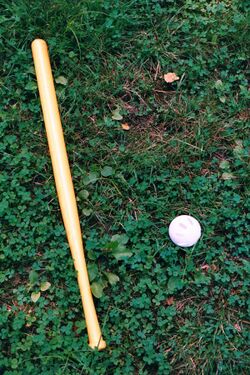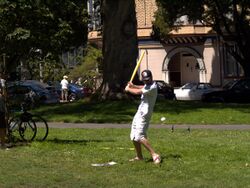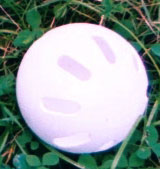Engineering:Wiffle ball
Wiffle ball, a team sport developed in 1953 in Fairfield, Connecticut, US is a scaled back variation of baseball designed for playing in a confined space.[1] The sport is played using a perforated light-weight plastic ball and a long hollow plastic bat. Two teams of one to five players each attempt to advance imaginary runners to home plate, and score, based on where each batter places the ball on the field. The term Wiffle ball may refer to the sport as a whole, or the ball used in the sport. Wiffle is a registered trademark of Wiffle Ball, Inc. and was derived from the slang word whiff meaning to strike out.[1]
History
Miniature versions of baseball have been played for decades, including stickball, improvised by children, using everything from rolled up socks to tennis balls. The ball most commonly used in the game was invented by David N. Mullany at his home in Fairfield, Connecticut in 1953[2] when he designed a ball that curved easily for his 12-year-old son. It was named when his son and his friends would refer to a strikeout as a "whiff". The Wiffle Ball is about the same size as a regulation baseball, but is hollow, lightweight, of resilient plastic, and no more than 1⁄8 inch (3.2 mm) thick. One half is perforated with eight .75-inch (19 mm) oblong holes; the other half is non-perforated. This construction allows pitchers to throw curveballs and risers.[citation needed]
In April 2011, the Health Department of the State of New York included wiffle ball on a list of recreational activities that present a "significant risk of injury" to children. Under a state law passed in 2009, any program for children that included two or more such activities would be defined as a “summer camp” subject to government regulation.[3] The story became a frequent source of ridicule and amusement, with Parenting.com sarcastically commenting, "According to new legislation introduced in New York State, to survive classic schoolyard games like capture the flag is to cheat death."[4] Wiffle ball executives originally thought the order was a joke. The company has never been sued over safety issues in its 50+ year history.[5] The disapproval of people from across the nation pressured the New York legislature to remove wiffle ball and other items such as archery and scuba diving from the list of risky activities.[6]
Game
The game became popular nationwide by the 1960s,[7] and is played in backyards, on city streets, and on beaches. The game is similar to baseball, and is designed for 2–10 players. A single game of wiffle ball consists of 6 innings or 60 minutes, whichever is earlier.[8][9]
To play the game, get a wiffle ball and a bat. If a bat is not available, a broomstick or other such stick may be used. Marking a playing field is not necessary, but if a field is marked, it is shaped like an isosceles triangle. The batter stands at the top of the triangle looking down the two equal sides that are about 60 feet in length. A ball hit about thirty feet counts as a "single" and a ball hit about 45 feet counts as a "double." When a ball is hit outside of the sides of the triangle, it counts as a foul ball. The line across the bottom of the triangle is about twenty feet in length, and a ball hit across this line counts as a "home run." Scoring of this game is similar to scoring in baseball as are the terms used, i.e., "single," "double," "foul ball" and "home run." However, there is no running around bases for the batter(s), and there is no chasing the ball for the pitcher and fielders.[9]
The object for each team in Wiffle ball is to score more runs than their opponent, thus winning the game. Once both teams have completed their agreed number of innings (usually six) or time limit has been reached, the team with the highest number of runs will be declared the winner. Should the number of runs be the same at the end of the game then the game is drawn. Some Wiffle ball leagues allow tied games and the points are shared equally by the two teams whereas others will insist on one more innings each, with the highest score being declared the winner.
Tournaments
Wiffle ball tournaments have been held in the United States and Europe since 1977. That year, Rick Ferroli began holding tournaments in his backyard tribute to Fenway Park in Hanover, Massachusetts.[10] In 1980, the World Wiffle Ball Championship was established in Mishawaka, Indiana by Jim Bottorff and Larry Grau. With the explosion of the Internet in the 1990s, there are now hundreds of Wiffle ball tournaments played in the United States, most in the same place every year, with a few tournament "circuits". The World Wiffle Ball Championship remains the oldest tournament in the nation, having moved to the Chicago suburbs in 2013, after introducing regional stops over three decades in Baltimore; Los Angeles; Indianapolis; Eugene, Oregon; and Barcelona, Spain.[11] The tournament is featured at #27 in the book, "101 Baseball Places to Visit Before You Strike Out."[12]
The NWLA (National Wiffle League Association) tournament is held in various Midwestern and Mid-Atlantic locations, which change on an annual basis. The tournament crowns a champion from a field of all-star teams from leagues across the country. [13]
Several organizations such as FastPlastic and Golden Stick have hosted universally recognized National Championships in the past. Currently, United Wiffle is the governing body for the tournament, as its inception took place in 2020 in York, Pennsylvania. The Usual Suspects were crowned champion, as the squad captained by Danny Lanigan defeated Black Dog Country Club 5-3 in the championship game. The scope of the tournament has since expanded to meet the criteria of a World Championship Tournament, with teams from Japan and Canada having competed in recent years. [14]
Leagues
There are many competitive wiffle ball leagues in the United States, including Major League Wiffle Ball (MLW) at the forefront. There have throughout history been other wiffleball leagues, such as the small wiffleball league started in June 2000 by Shaun Breen in the town of Cohoes, New York. The league operated until June 2004 and in its three years of operation it attracted players from Long Island, New York and garnered the attention of ESPN Magazine.[15]
The most viewed professional Wiffle Ball league as of 2023, is MLW Wiffle Ball. MLW was established by Kyle Schultz in Brighton, Michigan in 2009. The league consists of eight teams, which are the Eastern Eagles, Western Wildcats, Coastal Cobras, Midwest Mallards, Great Lakes Gators, Pacific Predators, Metro Magic, and Downtown Diamondbacks.
MLW has a strong following on social media, uploads highlights of all of their games to YouTube, and has also hosted open public tournaments in 8 different states (Michigan, Ohio, Arizona, Texas, Illinois, New York, Massachusetts, and Pennsylvania).[16] The league gained significant notoriety throughout its 2020 season, after several other professional sports were postponed or cancelled due to the COVID-19 pandemic. The league has been featured by TBS, The Athletic,[17] Whistle Sports, and twice been highlighted on ESPN's SportsCenter Top 10 Plays. They also have played games in states other than Michigan, like the Oklahoma Series, and they have also played in Fifth Third Field, home of the Toledo Mud Hens, a field of where Tiger Stadium used to be. In that same Detroit series, they were scheduled to play in Comerica Park, however, due to air quality postponements of Detroit Tigers games, the series was not played there. MLW has also played at a wiffle ball field at Citizens Bank Park in Philadelphia, Pennsylvania, home of the Phillies. In 2022, MLW made history by becoming the first wiffle ball league to play at SoFi Stadium, in which they played their 2022 World Series at, where the Diamondbacks swept the Cobras in 3 to win their second straight title. The most recent champions are the Metro Magic, managed by Jack Aigner.[18][19][20][21]
The name has also been associated with a small league in the southwestern Illinois city of Granite City,[22] which has come to be a hub of the sport with the Lakeside Kings having won multiple world championships in the Wiffle Ball National Championship Series. The League's inaugural national championship was held in October 2001 in Granite City,[23] whose wiffle only stadium[24] has long been known for its similarity to Fenway Park and Busch Stadium.[25] The national championship was launched following a decade long increase in interest in the sport,[26] among fans and players of all ages.[27]
As of 2015, there was also a sixty player league in Havre de Grace, Maryland, which featured former NBA player Gary Neal.[28]
In 2013, the Greater Cincinnati Wiffleball League was founded in Cincinnati, Ohio. The GCWL season runs from May through October. Averaging 10 teams and over 50 players each season, it is recognized as one of the premier wiffleball leagues in the United States.
Fields
Some wiffle ball players have built fields to resemble major league ballparks. Thomas P. Hannon, Jr. authored a book, Backyard Ball, on his experiences building a smaller version of Ebbets Field. Patrick M. O'Connor wrote a book, Little Fenway, about building his versions of Fenway Park and Wrigley Field.[29] But not all wiffle ball fields have been modeled from major league ball parks. Some have created original fields, Strawberry Field in Encino, California being the most exquisite. Rick Messina spent over $700,000 constructing Strawberry Field, which features lights for night games, bleachers, and a press box.[30] He also converted a neighboring house into a clubhouse/pub.[31]
Building fields can lead to controversy and legal issues. In 2008, The New York Times published an article about Greenwich, Connecticut teenagers who were forced by the city to tear down a wiffle ball field they had built because of neighbor complaints.[32]
In popular culture
In 1965 a wiffle ball was initially used when developing the sport of pickleball, but it was eventually replaced with a more durable ball.[33]
In his 2003 book The Complete Far Side, cartoonist Gary Larson reproduces a letter he received after including a "wiffle swatter" in his cartoon. The letter contains language from Wiffle Ball Incorporated's attorneys: "In the future, when you use the brand name WIFFLE, the entire brand should be capitalized, and it should only be used in reference to a product currently manufactured by The Wiffle Ball, Inc."[34][35] In 2009, video game developer Skyworks Technologies released a game based on Wiffle ball, simply titled Wiffle Ball.[36]
In science, it is frequently used by marine biologists as a size reference in photos to measure corals and other objects.[37][38]
References
- ↑ 1.0 1.1 "The Wiffle Ball, Inc. - A Brief History". http://www.wiffle.com/pages/game_rules.asp?page=game_rules.
- ↑ "What's 50, Curvy And Full of Air?; It's the Wiffle Ball, Still Popular, Holes and All". The New York Times. August 14, 2003. https://www.nytimes.com/2003/08/14/nyregion/what-s-50-curvy-and-full-of-air-it-s-the-wiffle-ball-still-popular-holes-and-all.html.
- ↑ Blain, Glenn (April 19, 2011). "Classic kids games like kickball deemed "unsafe" by state in effort to increase summer camp regulation – New York Daily News". Articles.nydailynews.com. http://articles.nydailynews.com/2011-04-19/local/29467776_1_summer-camp-recreational-activities-state-officials.
- ↑ "Playground Games Deemed Unsafe for Kids". Parenting.com. April 20, 2011. http://www.parenting.com/blogs/show-and-tell/parentingcom/wiffle-ball-freeze-tag-and-other-kid-games-deemed-unsafe.
- ↑ Blain, Glenn (April 20, 2011). "Wiffle Ball creators call scrapped New York state listing of backyard game as dangerous 'ridiculous' – New York Daily News". Articles.nydailynews.com. https://www.nydailynews.com/news/politics/wiffle-ball-creators-call-scrapped-new-york-state-listing-backyard-game-dangerous-ridiculous-article-1.113612.
- ↑ "State Officials Back Off Regulating Freeze Tag, Kids' Games". NBC New York. April 19, 2011. http://www.nbcnewyork.com/news/local/Freeze-Tag-Red-Rover-Deemed-Dangerous-in-New-Summer-Camp-Regs-120195644.html.
- ↑ "A Brief History of Wiffle Ball". 29 June 2014. https://www.mentalfloss.com/article/24609/it-curves-brief-history-wiffle-ball.
- ↑ "Wiffle Ball Rules & Field Dimensions". 13 July 2020. https://thepicklesports.com/wiffle-ball-rules/.
- ↑ 9.0 9.1 "The Wiffle Ball, Inc. – A Brief History". http://www.wiffle.com/pages/game_rules.asp?page=game_rules.
- ↑ "Wiffleball: A Connecticut invention that keeps giving back". 17 August 2011. http://patch.com/connecticut/shelton/wiffle-ball-a-connecticut-invention-that-keeps-giving-back-2.
- ↑ "World Wiffle Ball Championship". https://worldwiffleball.org/.
- ↑ "101 Baseball Places to Visit Before You Strike Out". http://www.lyonspress.com/book/9781493004782.
- ↑ "Official Site of the NWLA Tournament". NWLA Tournament. http://nwlatournament.com/.
- ↑ "United Wiffleball" (in en-US). https://www.unitedwiffleball.com/.
- ↑ Wood, Sylvia (August 6, 2001). "A Field of Dreams on a Cul-de-Sac". Albany Times Union. http://timesunion.com/searchalbany/results.asp?tulink=http%3A%2F%2Fsearch.talkingphonebook.com%2Ftusearch%2Fmegasearch%2Fnews-tu.jsp%3F&advancedFlag=true&showAllNewsFlag=true&keywords=wiffle+ball+Sylvia+Wood&fromdate=08%2F01%2F2001&todate=08%2F31%2F2001&withwords=%22Sylvia+Wood%22+cul-de&phrase=&withoutwords=&intitle=true&inauthor=true&fromdatemonth=08&fromdateday=01&fromdateyear=2001&todatemonth=08&todateday=31&todateyear=2001.
- ↑ "MLW Wiffle Ball - (Brighton, MI) - powered by LeagueLineup.com". https://www.leaguelineup.com/miscinfo.asp?menuid=34&url=mlwcultzfield.
- ↑ Nesbitt, Stephen J.. "MLW Wiffle Ball started as a neighborhood league among friends. Now it's a burgeoning business" (in en). https://theathletic.com/3009763/2021/12/28/mlw-wiffle-ball-started-as-a-neighborhood-league-among-friends-now-its-a-game-and-a-business/.
- ↑ MLW Wiffle Ball - (Brighton, MI) - powered by LeagueLineup.com
- ↑ "How the DN sports staff is handling life without sports". The Daily Nebraskan. March 20, 2020. http://www.dailynebraskan.com/sports/how-the-dn-sports-staff-is-handling-life-without-sports/article_e6bcf42e-6a42-11ea-8c41-fbea87e70290.html.
- ↑ Banks, Matt (September 5, 2020). "Major League Wiffle Ball: How a playground game became an internet sensation". SW Londoner. https://www.swlondoner.co.uk/sport/05092020-major-league-wiffle-ball-playground-game-internet-sensation/.
- ↑ "How Major League Wiffle Ball is turning a classic summer game into a sport". Inverse. https://www.inverse.com/mind-body/not-sports-major-league-wiffle-ball.
- ↑ "Baseball – Wiffle Ball Championships". Belleville News-Democrat. October 18, 2001. http://nl.newsbank.com/nl-search/we/Archives?p_product=ND&s_site=belleville&p_multi=ND&p_theme=realcities&p_action=search&p_maxdocs=200&p_topdoc=1&p_text_direct-0=0EF7B341F6927DA6&p_field_direct-0=document_id&p_perpage=10&p_sort=YMD_date:D&s_trackval=GooglePM.
- ↑ Kloeckner, Rod (October 20, 2001). "Wiffle Ball Championship Comes to Granite". Belleville News-Democrat. http://nl.newsbank.com/nl-search/we/Archives?p_product=ND&s_site=belleville&p_multi=ND&p_theme=realcities&p_action=search&p_maxdocs=200&p_topdoc=1&p_text_direct-0=0EF66F1E31A59AA2&p_field_direct-0=document_id&p_perpage=10&p_sort=YMD_date:D&s_trackval=GooglePM.
- ↑ Fatsis, Stefan (August 6, 1999). "The Wiffle Kings". Wall Street Journal. http://online.wsj.com/article/SB933893925470349349.html?mod=googlewsj.
- ↑ Wheatley, Tom (October 18, 1991). "Playing Field Has a Touch of Busch, Fenway All in One". St. Louis Post-Dispatcher. http://nl.newsbank.com/nl-search/we/Archives?p_product=SL&p_theme=sl&p_action=search&p_maxdocs=200&p_topdoc=1&p_text_direct-0=0EB04D6156F5E8EF&p_field_direct-0=document_id&p_perpage=10&p_sort=YMD_date:D&s_trackval=GooglePM.
- ↑ Peterson, Anne (August 1, 1991). "To Aficianados, Wiffle Ball is Serious Sport". Akron Beakon-Journal. http://nl.newsbank.com/nl-search/we/Archives?p_product=AK&s_site=ohio&p_multi=AK&p_theme=realcities&p_action=search&p_maxdocs=200&p_topdoc=1&p_text_direct-0=0EB62D0FEB0E1AB3&p_field_direct-0=document_id&p_perpage=10&p_sort=YMD_date:D&s_trackval=GooglePM.
- ↑ "Wiffle Ball Association Turns Kid's Sport into Adult Mania". St. Louis Post-Dispatcher. August 11, 1991. http://nl.newsbank.com/nl-search/we/Archives?p_product=SL&p_theme=sl&p_action=search&p_maxdocs=200&p_topdoc=1&p_text_direct-0=0EB04D4BB1F49C0D&p_field_direct-0=document_id&p_perpage=10&p_sort=YMD_date:D&s_trackval=GooglePM.
- ↑ McRoberts, Randy (May 21, 2015). "Havre de Grace Major League Wiffle league opens season with visit from NBA's Gary Neal". The Chicago Tribune. https://www.chicagotribune.com/ph-ag-hdg-wiffle-ball-league-0522-20150521-story.html.
- ↑ "Official Site of the Little Fenway Wiffle Ball Field Located in Jericho, VT". Little Fenway. http://littlefenway.com/fenway/home.php.
- ↑ "Wiffle Ball Hits Home – Los Angeles Times". Los Angeles Times. October 11, 2000. http://articles.latimes.com/2000/oct/11/news/cl-34552.
- ↑ Wiffle Ball: The Ultimate Guide by Michael Hermann, pages 107–110
- ↑ Peter Applebome (July 10, 2008). "Our Towns – Build a Wiffle Ball Field and Lawyers Will Come". The New York Times. Greenwich, Connecticut. https://www.nytimes.com/2008/07/10/nyregion/10towns.html?em&ex=1215835200&en=c84dff99e1e7a1fd&ei=5087%0A.
- ↑ Lucore, Jennifer; Youngren, Beverly (2018). History of pickleball : more than 50 years of fun! (First ed.). Oceanside, CA: Two Picklers Press. p. 11. ISBN 978-1-7320705-0-9.
- ↑ "How the Wiffle Ball Came to Be". https://www.smithsonianmag.com/innovation/how-wiffle-ball-came-to-be-180972900/.
- ↑ Larson, Gary (2003). The Complete Far Side. 2. Andrews McMeel Publishing. p. 71. ISBN 0-7407-2113-5.
- ↑ Bedigian, Louis (April 30, 2007). "Wiffle Ball Review". https://nds.gamezone.com/gzreviews/r31432.htm.
- ↑ "Live Webcams: Scientists Studying Corals Damaged by Oil in the Gulf of Mexico". Penn State Science. 25 June 2014. http://science.psu.edu/news-and-events/2014-news/Fisher6-2014.
- ↑ "PHOTOS & VIDEO". Nautilus Live. http://www.nautiluslive.org/photo/2013/06/25/wiffle-ball-marker.
External links
 |




